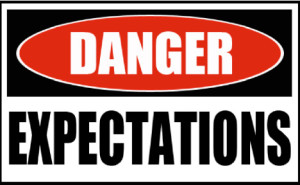By Cherie Shanteau-Wheeler for EDRblog.org.
 For several years my role has been as a mediator, facilitator and/or attorney working in complex, multi-party environmental settings. I have finally faced facts—people are living in their own fantasy worlds. You are all laughing at me already, right? “Really?” You say. “She has just figured this out?” I am focusing on this unusually deep insight on my part to make a point—that in our work as professional mediators, facilitators, and even as attorneys who are trying to settle an apparently simple dispute, it’s often ALL about expectations. Unless we focus on the concept of what people’s expectations truly are, the odds of being helpful are not as great.
For several years my role has been as a mediator, facilitator and/or attorney working in complex, multi-party environmental settings. I have finally faced facts—people are living in their own fantasy worlds. You are all laughing at me already, right? “Really?” You say. “She has just figured this out?” I am focusing on this unusually deep insight on my part to make a point—that in our work as professional mediators, facilitators, and even as attorneys who are trying to settle an apparently simple dispute, it’s often ALL about expectations. Unless we focus on the concept of what people’s expectations truly are, the odds of being helpful are not as great.
I am a great fan of interest-based negotiation. It is a fundamental tool to help solve problems more productively. It is engrained in the fiber of my professional being. But, expectations can get in the way of making headway even if people recognize each other’s needs. This is a particularly challenging problem when you are working with lots of people with divergent views about the issues (many technically complex), individual expectations about their roles in the process, the best way to reach the solution, or even expectations about what the problem actually is.
To be notified when new EDR blog articles are posted, please sign up for our listserv »
Here are some examples of what “expectations” can look like in a multi-party environmental or public lands setting. They can arise when a federal agency reaches out to the public for input—maybe in an exploratory way or within a NEPA[2] process. What people hear and then expect can run the gamut from “now I can influence the decision” to “now I can make the decision for you,” and everything in between. During my years with the Federal Government at the U.S. Institute for Environmental Conflict Resolution[3], agency staffers complained to me: “We are told by the Washington Office that we must collaborate with the public but when we announce this, the expectation of many is that we are somehow turning decision-making over to them.” Role confusion ensues! Misunderstandings can and do occur immediately often producing the potential for the old approach-avoidance challenge for agency staff who appreciate the importance of communicating with the public but are also stressed by the public expectations that follow. IAP2[4] and others have created great spectrums that we all rely upon to describe what collaboration is, isn’t, and can be. They are hugely beneficial to educate practitioners, public agency staff, professionals of all sorts and the public at large. The challenge for most agencies is how to set the stage for an input process that better prepares stakeholders and interested parties for what is actually being offered to them. Clarifying the “input space” is a preliminary task that environmental conflict resolution (ECR) practitioners use as part of the active process management that Pat Field recently described in his July 6 blog post. Assisting parties to understand what is needed from them and how their input will be used by the agency is critical to managing role expectations and helps avoid much of the unhappiness about next steps and, possibly, a result.
Agreeing on how a solution should be reached is another opportunity to run into expectancy challenges. Chris Moore, one of the experts in our field and the author of The Mediation Process[5], came up with the brilliant idea of the Triangle of Satisfaction, a beautifully efficiently model to address the three distinct but interrelated types of interests that are bound to the outcomes of negotiation and mediation processes—substantive interests, psychological or emotional interests (e.g. thoughts and feelings), and process interests. Expectation of process fairness, inclusivity, timing and transparency are growing as stakeholders and interested parties become more sophisticated about public process. In addition, with more technically experienced stakeholders, there may be differing expectations about what the technical elements of a solution process should be. The resulting conflicts can present some rather serious challenges to achieving implementable solutions. I have found that it is always a good idea to assist parties to either develop a process together or become better educated about an institutionalized process in an open and transparent manner. The odds are that it will not only help rejigger expectations, but will also help improve psychological satisfaction, and contribute to better addressing the substantive issues as well.
But, here is one of the most difficult expectancy challenges–how can individual expectations be met or can people work together effectively when they do not even agree on what they see as the problem to be addressed? Some might say—isn’t the problem obvious–we are talking about spotted owls. Or are we? Might we actually be talking about riparian health? or Old-Growth forests? or viable local economies? or Tribal sovereignty? or something else–even though we are all looking at the same forest??
 Cherie Shanteau-Wheeler is a Senior Associate at Triangle Associates, Inc.—a consulting firm committed to helping people understand and resolve public policy issues and environmental conflicts. Cherie joined Triangle in the Fall of 2014 after over 13 years as a federal employee at the U.S. Institute for Environmental Conflict Resolution, a program of the Udall Foundation, where she provided collaboration and conflict resolution services on environmental, natural resources and public lands issues that included federal agencies and issues. Prior to that Cherie practiced law and mediated disputes for over 17 years.
Cherie Shanteau-Wheeler is a Senior Associate at Triangle Associates, Inc.—a consulting firm committed to helping people understand and resolve public policy issues and environmental conflicts. Cherie joined Triangle in the Fall of 2014 after over 13 years as a federal employee at the U.S. Institute for Environmental Conflict Resolution, a program of the Udall Foundation, where she provided collaboration and conflict resolution services on environmental, natural resources and public lands issues that included federal agencies and issues. Prior to that Cherie practiced law and mediated disputes for over 17 years.
[1] Image from: http://brandonconvery.com/expectation/
[2] NEPA is the acronym for the National Environmental Policy Act, enacted on January 1, 1970.
[3] The U.S. Institute for Environmental Conflict Resolution, is program of the Morris K. Udall and Stewart L. Udall Foundation, a federal agency with offices located in Tucson, Arizona and Washington, D.C.
[4] The International Association for Public Participation.
[5] Moore, Christopher W., The Mediation Process: Practical Strategies for Resolving Conflict 4th Ed. (2014) San Francisco Jossey Bass
